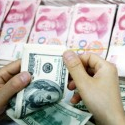The rise of the Chinese renminbi (RMB) and its increasing importance in cross-border trades has accelerated since the Great Financial Crisis hit the west in 2008-2009. Since then, the US economy has experienced a number of problems in the long-term such as:
- Unsustainable fiscal deficit;
- Lowering growth of GDP;
- Weakening of US Dollar against other currencies.
The factors listed above have led to speculations over what alternatives to US dollar and its global dominance may arise in the near future.
Obviously, the benefits of the US dollar as the backbone of international trade cannot be easily overlooked. The currency provides a stable savings flow and has a very low possibility of default, conveniently hedging exchange rates risks and long established trust in its – at least until the crash of 2008.
One development in the scope of decreasing the world dependence on US dollar was the design of the Special Drawing Rights (SDR) basket by the IMF in 1969 to reduce world reliance on US treasuries. Potentially, the SDR could be used as an alternative to US dollar.
The latest news is that IMF representatives have given China strong signals that the RMB is likely to soon join SDR basket. In this case at least 1 trillion USD is expected to be invested to Chinese assets.
This would be a big step towards RMB becoming a reserve global currency.
Until now, the RMB has not had reserve currency status due to the following of reasons:
- A lack of trust in the Chinese government;
- RMB exchange rates not being completely free floating;
- Political and economic instabilities in China.
This is not to discount the huge strides that have been taken to make the Chinese market and its currency more accessible to foreign investors.
In 2005, the RMB was depegged from USD and pegged instead to a managed basket of foreign currencies that includes the USD, Euro, Yen, Korean Won, GBP and several others. The weights of the currencies are based on their trading volumes. Currently the exchange rate for the RMB is allowed to float but restrictions are applied by Chinese Government. The main reason that RMB exchange rates not allowed to float completely is that sustaining lower exchange rates for the Yuan increases the volume of China’s exports. However, the window for rate fluctuation went from 0.5% to 2% in 2015, indicating the government’s intent to transition to a free market.
Before the sub-prime crisis and the start of QE in the United States, World Bank and IMF economists claimed that the Yuan was undervalued by as much as 37%. After the introduction of QE, the RMB may have returned to its equilibrium due to the decline in the value of US Dollar.
Below is the timeline with main events that show major steps towards internationalisation of RMB.
A major event in the internationalization of the RMB was the establishment of Cross-Border Trade Settlement Project in 2008. Before that, all international transactions with China were performed using USD.
- 2009 direct currency swaps were established from Shanghai and Guangdong to Hong Kong, Macau and ASEAN (Brunei, Cambodia, Indonesia, Laos, Malaysia, Myanmar, Singapore, Philippines, Thailand, Vietnam) countries.
- 2010 Russia starts direct currency swaps with China
- 2011 Japan joins. RMB surpasses Russian Ruble in international trading volume
- 2013 UK is the first G7 country to set up official currency swap with China
- 2014 China has currency swap agreements with 25 Central Banks with total amount of 2.7 trillion Yuan. 10,000 financial institutions are using RMB and 18% of total China trade is settled in RMB.
- 2015 China launches International Payment System as alternative to SWIFT. Chicago Mercantile Exchange starts trading in RMB futures
Here is the diagram showing growth in cross-border settlements since 2012 in millions of Yuan.
By the end of 2014, the RMB was the fifth most traded currency in the world, according to a SWIFT report, with 2.2 % or cross-border trades cleared in RMB just behind JPY. By the beginning of 2015, the RMB was the second most used currency in trade financing. The growth of currency swaps in RMB and the internationalisation of the trading process is indicative of the speed of RMB adaption in the world economy.
Other major mechanisms that took China towards open market system are:
- Offshore RMB denominated bond market – aka “dim sum” bonds;
- Launch of onshore RMB denominated bonds – aka “panda” bonds;
- Creation of stock-connect between Hong Kong and mainland stock exchanges.
Below is the chart showing the growth in “dim sum” bonds trade:
The total return on “dim sum” bonds has been growing as well (the index below measures fixed income RMB instruments return performance with starting value of 100 on May, 31 2011):
In May 2015, several of the world top financial institutions including HSBC and Morgan Stanley were given regulatory approval to access the interbank bond market in China. The sale of on-shore bonds, or so called “panda” bonds, is expected to overtake “dim sum” bonds which, at this stage, simply cannot meet investors demand. Supranational organisations such as the World Bank and sovereign wealth funds can now trade in “panda” bonds without prior approval.
The growth of non-resident deposits in RMB since 2011 has been tremendous. Graph below shows deposits in billions of Yuan.
Together with “dim sum” and “panda” bonds market, the stock connections established between Shanghai and Hong Kong, and the announcement of a second one Shenzhen and Hong Kong in progress, the Chinese market is becoming a major arena for international investments. It remains to be seen if rapid changes in Chinese economy will continue to accelerate further or if Chinese government will put the brakes in place in order to maintain the State control over the country’s affairs.
The Cambridge Centre for Risk Studies examines the potential economic impact of the collapse of dollar hegemony to the RMB in the Dollar Deposed Financial Catastrophe stress test, due for final publication in December 2015.











Leave a Reply